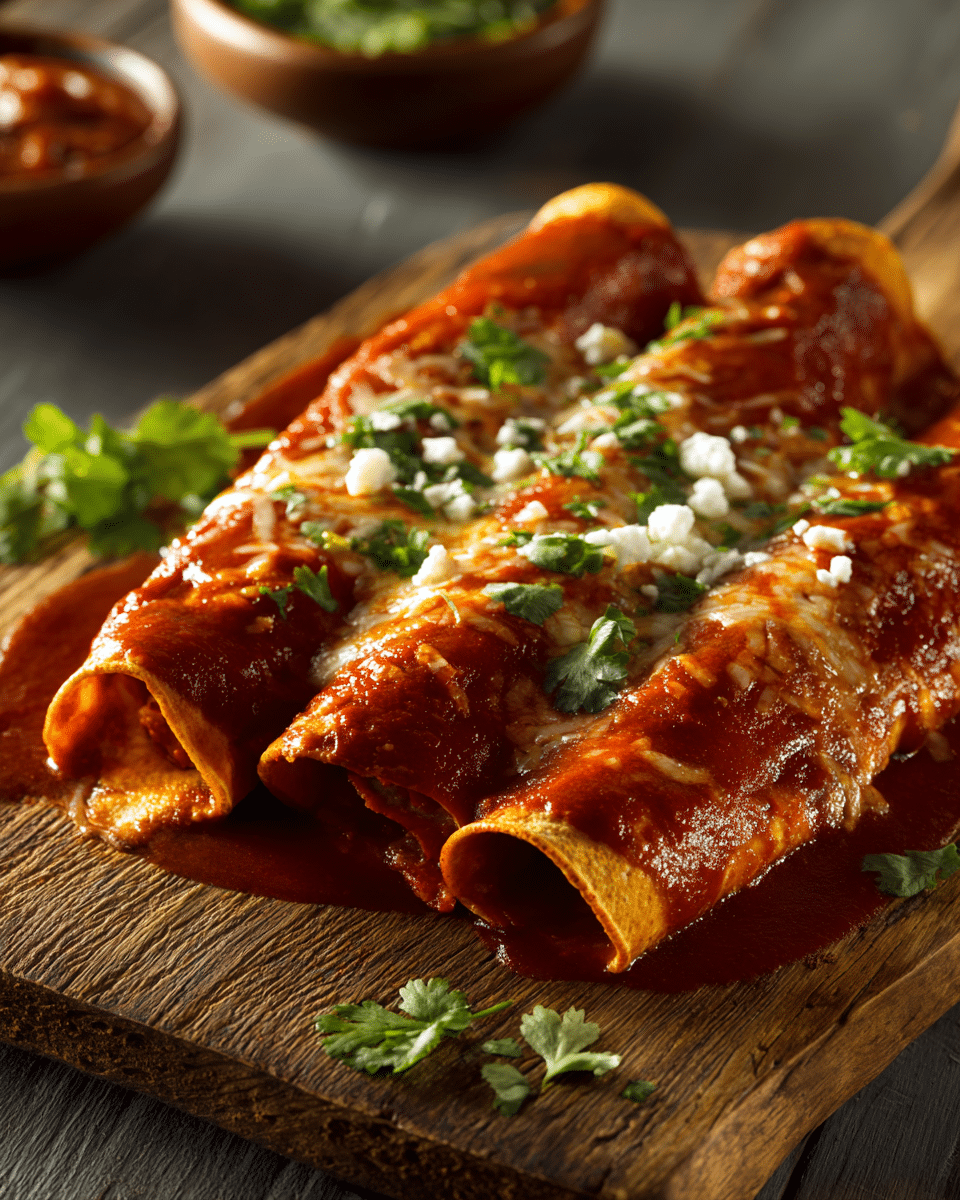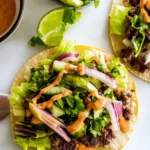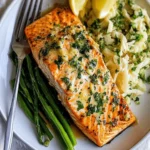Enchiladas Rojas o Verdes are a beloved staple in Mexican cuisine, especially during celebrations like Mexican Independence Day. These saucy tortilla rolls are filled with savory ingredients such as shredded chicken, cheese, or vegetables, then generously coated with either a tangy green tomatillo sauce or a rich, smoky red chili sauce.
FULL RECIPE
Ingredients
- 12 corn tortillas
- 2 cups cooked, shredded chicken (or cooked vegetables for vegetarian version)
- 2 cups shredded queso fresco, Monterey Jack, or Oaxaca cheese
- 1 cup sour cream (optional for topping)
- 1 small onion, finely chopped
- 1 tablespoon vegetable oil (plus more for frying tortillas)
- Salt and pepper, to taste
1.For Red Sauce (Rojas):
- 4 dried guajillo chiles, stems and seeds removed
- 2 dried ancho chiles, stems and seeds removed
- 2 garlic cloves
- 1 small tomato, chopped
- 1 cup chicken broth
- 1 teaspoon cumin
- Salt, to taste
2.For Green Sauce (Verdes):
- 8 tomatillos, husked and rinsed
- 2 serrano or jalapeño peppers (adjust to taste)
- 2 garlic cloves
- 1 small onion, chopped
- 1 cup chicken broth
- 1/2 cup fresh cilantro leaves
- Salt, to taste
Directions
- Prepare the Sauce:
- For Red Sauce: Boil the dried chiles for 5–7 minutes until softened. Blend with garlic, tomato, chicken broth, cumin, and salt until smooth. Strain if desired. Simmer for 5 minutes.
- For Green Sauce: Boil tomatillos and peppers for 5 minutes. Blend with garlic, onion, chicken broth, cilantro, and salt until smooth. Simmer for 5 minutes.
- Warm the Tortillas: Heat a little oil in a skillet and lightly fry each tortilla for 10–15 seconds per side to make them pliable. Drain on paper towels.
- Assemble the Enchiladas: Place shredded chicken and a little cheese in the center of each tortilla. Roll up tightly and place seam-side down in a baking dish.
- Sauce the Enchiladas: Pour your choice of sauce (red or green) generously over the rolled tortillas. Sprinkle remaining cheese on top.
- Bake (Optional): If you prefer melted cheese on top, bake at 350°F (175°C) for 10 minutes until cheese is bubbly.
- Serve: Garnish with sour cream, chopped onion, and fresh cilantro. Serve immediately with rice and beans.
Nutrition Facts
- Calories: 320
- Protein: 18g
- Carbohydrates: 28g
- Dietary Fiber: 4g
- Sugars: 3g
- Fat: 15g
- Saturated Fat: 6g
- Cholesterol: 55mg
- Sodium: 620mg
- Potassium: 480mg
Flavor Profiles of Red and Green Sauces
The red and green sauces in enchiladas offer distinct yet equally satisfying flavor experiences. Red sauce, made from dried chiles such as guajillo or ancho, is earthy, smoky, and slightly sweet, often with a mild to moderate heat level. The green sauce, crafted from tomatillos, cilantro, and fresh chiles, is tangy, herbaceous, and bright, bringing a refreshing balance to the richness of the fillings. The choice between the two can reflect regional preferences, family tradition, or the desire for specific flavor contrasts. Many cooks even prepare both, allowing guests to enjoy a festive “rojas y verdes” plate that showcases the versatility of this beloved dish.
Nutritional Value and Health Benefits
While enchiladas are often viewed as indulgent comfort food, they can be surprisingly nutritious when prepared thoughtfully. Corn tortillas provide a source of complex carbohydrates and dietary fiber, while lean fillings like chicken or vegetables contribute protein and essential vitamins. Red chile sauces are rich in antioxidants such as vitamin A and capsaicin, which may support heart health and boost metabolism. Green sauces made from tomatillos and cilantro are high in vitamin C and phytonutrients that support immune function. Choosing low-fat cheese or reducing the amount of frying can make enchiladas a healthier option without sacrificing flavor.
Filling Options and Customizations
One of the best aspects of Enchiladas Rojas o Verdes is their adaptability to various fillings. Shredded chicken is a classic choice, but beef, pork, or seafood also work beautifully. Vegetarians often opt for cheese, beans, sautéed mushrooms, or roasted vegetables. For a more gourmet touch, fillings like spinach with ricotta, roasted poblano peppers, or squash blossoms can be used. Cooks can adjust seasoning and spice levels to suit their audience, making this dish suitable for both mild and adventurous palates. Creative fillings also allow for seasonal variations, ensuring the dish remains exciting year-round.
Serving and Garnishing Suggestions
Presentation plays a key role in enhancing the enjoyment of enchiladas. Once plated, they can be garnished with fresh cilantro leaves, crumbled queso fresco, sliced onions, or a drizzle of crema for a visually appealing and flavorful finish. For a pop of texture, consider topping them with crispy tortilla strips or toasted pumpkin seeds. Serving enchiladas alongside traditional accompaniments such as Mexican rice, refried beans, or a fresh salad balances the meal. A squeeze of lime over the top before eating can brighten the flavors, especially for the green version.
Pairing with Drinks and Sides
Enchiladas Rojas or Verdes pair wonderfully with a variety of beverages. A cold Mexican lager or light pilsner complements the smoky and tangy sauces without overpowering them. For non-alcoholic options, aguas frescas such as horchata, jamaica (hibiscus), or tamarindo offer refreshing sweetness to balance the savory flavors. Sides like esquites (Mexican street corn salad), guacamole, or a tangy cucumber and radish salad provide textural and flavor contrast. The combination of warm enchiladas with cool, crisp sides creates a balanced dining experience perfect for gatherings.
Regional Variations in Mexico
Enchiladas take on unique forms depending on the region of Mexico in which they are made. In the north, flour tortillas are sometimes used instead of corn, while in the central regions, corn remains the standard. Oaxaca is known for mole-based enchiladas, while in San Luis Potosí, “enchiladas potosinas” use chile-infused tortillas. The choice of cheese, garnishes, and sauces can vary widely, with some regions favoring spicier profiles and others leaning toward mild, tomato-forward flavors. Understanding these variations offers a deeper appreciation for the diversity within Mexican cuisine.
Storage and Reheating Tips
Enchiladas are ideal for meal prep, as they store well and can be reheated without losing much flavor. When storing, keep the sauce separate from the rolled tortillas to prevent them from becoming overly soggy. Both can be refrigerated for up to 3 days or frozen for up to 2 months. To reheat, bake covered in the oven at 350°F until heated through, adding extra sauce if needed. If frozen, allow them to thaw in the refrigerator overnight before reheating. This makes enchiladas a practical choice for busy households or planned gatherings.
Making Enchiladas Ahead for Events
For parties and family celebrations, enchiladas can be assembled in advance and baked just before serving. This approach not only saves time during the event but also allows the flavors to meld together for a richer taste. Preparing both red and green versions offers guests variety and enhances the visual appeal of the buffet. Keeping sauces warm in separate pots allows for customizable plating, so guests can choose their preferred sauce—or even enjoy a combination on a single plate.
Tips for Perfecting the Dish
Achieving restaurant-quality enchiladas at home requires attention to a few details. Lightly frying tortillas before rolling prevents them from tearing and helps them absorb the sauce without becoming mushy. Straining the sauce after blending results in a smoother texture, while simmering it briefly deepens the flavor. Using freshly made tortillas can elevate the dish, as their warm, pliable texture holds up beautifully to filling and saucing. Finally, balancing seasoning in both the filling and sauce ensures every bite is flavorful.
Conclusion
Enchiladas Rojas o Verdes are more than just a delicious meal—they are a celebration of Mexican heritage, flavor diversity, and culinary creativity. Whether served as part of a family dinner, at a festive holiday gathering, or in a casual weeknight setting, they offer endless possibilities for customization and enjoyment. Their bold colors, rich sauces, and comforting textures make them a dish that connects people to tradition while leaving room for modern interpretation.






